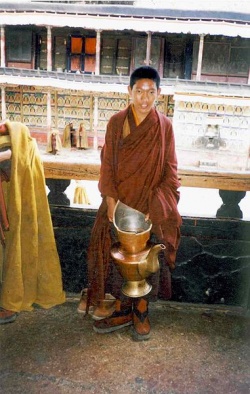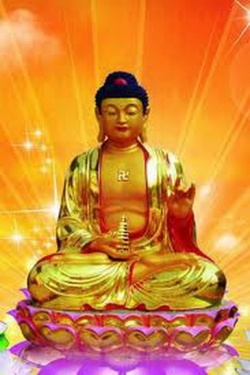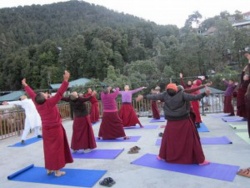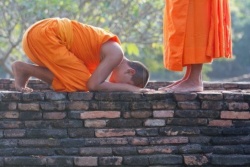The National Library and Archives of Bhutan
A review of the National Library and Archives of Bhutan (འབྲུག་རྒྱལ་ཡོངས་དཔེ་མཛོད་དང་ཡིག་རིགས་གཏན་འཇོག་ཁང་།) in Thimphu, Bhutan.
In Bhutan, as with many Himalayan Buddhist cultures, key texts were considered auspicious objects that were traditionally kept in temples, monasteries and private homes, for ritual use and/or propitiation. When the National Library and Archives of Bhutan (འབྲུག་རྒྱལ་ཡོངས་དཔེ་མཛོད་དང་ཡིག་རིགས་གཏན་འཇོག་ཁང་། or NLAB) was founded in 1967, the country did not yet possess a strong library or research culture. This has changed drastically, and at present NLAB is a national leader in research, conservation, education, and publication, providing otherwise unavailable material on Bhutanese history, religion and culture, as well as on the broader Himalayan region. As a specialist in Himalayan art history, I have been actively using the collection since 2007 and have maintained a formal research affiliation there since 2012.
About the National Library and Archives
Founded by the Third King of Bhutan Jigme Dorji Wangchuck (1929-1972), the core of the National Library collection initially consisted of 120 Buddhist manuscripts donated by the late Queen Mother, Ashi Phuntsho Choden (1911-2003), at the time of the library’s inception. Since then, the collection has expanded substantially and its holdings have a remarkable online presence, thanks to a collaborative initiative with the Royal Library Denmark. The collection is most useful for scholars of Bhutanese, Tibetan, and broader Himalayan history and religion.
Today, the NLAB complex consists of three buildings: the main building, which houses the Chokey (Classical Tibetan) and Dzongkha collection; an administration block that also contains the foreign language collection; and the archives building, which is not publicly accessible to the public.
Registration Procedures
Stays of any duration in Bhutan require a government-issued visa. There are no visas on arrival, so visits must be arranged in advance. Research visas to Bhutan can be difficult to secure, and require at least 6 to 12 months of advance planning and direct discussions with potential host institutions. Personally, I recommend to budget no less than 9 months for the entire process. More information on visas to Bhutan can be found here. Indian nationals are an exception to this rule and can travel freely across the Indo-Bhutanese border.
Entry to NLAB is free, but access to specific research materials should be scheduled in advance. Upon arrival, researchers will sign in at the front desk and furnish any requested documentation, which might include passport, letter of invitation, and/or valid visa. Visitors who are employing a tour agency will be able to facilitate research visits to the library and can advise on specifics for your particular situation, but do tell the agent well in advance of your intention to conduct research.
After signing in, researchers will be shown to the reading area, located on the ground floor of the main building. Library staff will explain the institution’s rules (no loud talking, gum chewing, photography, etc.) then retrieve requested materials for use. There are no additional fees to conduct onsite research.
To undertake longer-term projects, it is necessary to arrange a research stay in advance with the Research Division or Archives Division. Proposals should outline the duration of the stay, specific materials requested, and objectives of the study. In my experience, it is best to arrange these stays as far in advance as possible, and plans should be finalized with the library prior to buying air tickets. Personally, I submit proposals for review and approval at least nine months ahead of my desired arrival date.
Accessing the Collections
Researchers and guests are not allowed in the archives building; however, the 6,900 volumes of the foreign language collection, located on the ground floor of the administration building, are free for use in the library. There, readers will find a wealth of material on South Asian and Himalayan history, art and culture in English, Nepali, Hindi and other regional languages, as well as a smattering of European language offerings.
The main building holds Chokey (Classical Tibetan) and Dzongkha materials. Traditional format texts (dpe cha) are kept on three floors and are arranged primarily by Buddhist tradition or, in certain circumstances, by textual genre. Each section has been assigned a specific color cloth wrapping; specifically, blue for Bon (bon), orange for Kagyu (bka’ rgyud), yellow for Gelug (dge lugs), red for Nyingma (rnying ma), green for Sakya (sa skya), orange for Buddhist Philosophy (root texts and commentaries), and pink for Rigney (rig gnas; traditional arts and sciences). Each level has an active Buddhist shrine dedicated to different Buddhas, bodhisattvas, historical masters, and teachers.
Visitors are not allowed to directly access works in the main building, but are free to walk around the upper levels. Material is arranged according to a classification system, available online. To use traditional materials housed upstairs, researchers must arrange for staff to retrieve specific materials for use in the reading room. Chokey and Dzongkha holdings that have Western-style bindings are located on the ground floor of the main building, surrounding the reading room. The reading room is staffed and closely monitored during all open hours, and there is a surveillance system. The staff may request to inspect books and/or personal property when leaving the library.
State of Digitization
Presently, NLAB have a searchable online database that employs the Extended Wylie Transliteration System (EWTS). This is accessible worldwide and is an indispensable resource when planning your visit. Onsite, the main building has free public access computers available to browse and locate material in the catalog. It should be noted that some titles may be difficult or impossible to see when scanning the shelves, and as such the online database is the best way to view the holdings. Further, researchers are rarely able to access material “on demand”, so shelf-reading might be an exercise in frustration (or provide tantalizing reasons to return).
These were digitized through the Danida Danish International Development Assistance) Twinning Project launched in 1996 in collaboration with the Royal Library of Denmark. Completed in 2010, the online database has 13,625 searchable volumes and approximately 120,000 records (Felicity Shaw, Conserving Our Heritage: Evolution of the National Library of Bhutan. Thimphu: National Library and Archives of Bhutan, 2013, pp. 109). It is possible to email records from within the system for ease of reference. However, it is advised to check the functionality of the e-shelf (labeled “basket”) before relying upon it too heavily. Records are in the process of being re-edited, but for the most part are reliable.
Current digitization projects at NLAB include the digitization of land records from 1965-1968 and late 1970s-early 1980s. Access to these materials is granted through the Home Ministry on a case-by-case basis (Shaw, Conserving Our Heritage, pp. 90). The library is also in the midst of a multi-year National Literary Documentation Survey project to digitize rare materials from private collections and institutions throughout the country, some of which have been made publicly available, including biographies of religious masters and ritual texts. Another initiative in process is the documentation and digitization of historical photographs of Bhutan.
Duplication/Reproduction Guidelines
Photocopying service is not available, and digitized works cannot be printed out on site. Photography is strictly prohibited. Computers are allowed into the reading room, and researchers may transcribe documents. There is no secured wi-fi access in the NLAB complex.
The library allows for one file to be downloaded to the user’s workstation without payment or further permission, provided this is done solely for purposes of private study and that it includes the copyright notice and reference as found on each file. These may not be duplicated, published or disseminated through hard copies or by electronic means without explicit permission from the copyright holder, with the exception of academic use in lectures. Permissions for more public uses of NLAB material can be sought directly from the Director.
As NLAB is a popular destination with tourists, visitors should anticipate the possibility of groups moving through the building, some of whom can be quite talkative.
Be aware that there is no centralized heat or air conditioning in the buildings, and accordingly, the environment reflects the season. It can be quite cold indoors in winter and space heaters/heating elements are not allowed.
In addition to the study area in the main building, there are about ten tables with chairs available in the foreign language section in the administrative block. Materials from the main library cannot be brought out of the building and must be used at the study tables on the ground floor. In my experience, staff members are courteous and quite efficient. As with any institution, newer team members often require some time to get familiar with the collection, but there are veterans on hand to assist.
General Advice and Guidance
Visitors should keep in mind that NLAB actively maintains three shrines within the main building, and it is accordingly considered a sacred space. Loud talking, smoking, music, eating and drinking are not allowed; neither is touching the shrines. While Thimphu does not suffer frequent power outages, power outlets are not always available for public use.
NLAB is an active publisher of traditional pecha and Western format books (in English and Dzongkha), as well as zung (consecratory materials) and mantras for ritual use. Many titles that are otherwise unavailable can be found in the NLAB bookshop, located on the south side of the ground floor of the administration building, adjacent to the parking lot. The bookshop maintains the same hours as NLAB and also carries select titles from the National Museum of Bhutan (Paro) and the Centre for Bhutan Studies.
The administration building also houses a woodcarving section where trained team members carve new and replacement woodblocks. Currently, the master carver is working on a replacement 21-volume set of the biography of Pema Lingpa (1450-1521). There is also a conservation department, which assists with the restoration of items from both outside and inside the NLAB collection. Staff may be able to arrange or accommodate a visit to these sections with advance notice.
There is a small parking lot that is free for the duration of your visit, but it is worth noting that this might change once the Department of Culture shifts to the large building currently under construction next to the National Library. There is a public transit stop nearby, served by city bus routes 6 and 8. Thimphu is pedestrian-friendly, though taxis are abundant.
Location and General Information
Kawajangsa, Thimphu
Located just below the School for the Thirteen Traditional Arts (Zorig Chusum) and Folk Heritage Museum.
Website: www.library.gov.bt
Phone: +975 2 324314 , +975 2 333301
Email: library.bhutan@gmail.com
Summer hours (March-October): 0900-1700 Winter hours (November-February): 0900-1600
Closed all official government holidays
Lunch hours are: 1300-1400. But due to the large number of visitors, there is always someone on staff in the main building during public hours.
When you are ready for a bite, the closest two options are the Folk Heritage Museum, which has a small restaurant just above the library (from Nu. 2,000 per person). Smaller budgets will find satisfaction at a small buffet-style restaurant (Nu. 150 per person) near the Ministry of Education and the WWF buildings, a local favorite located slightly above and to the south of the library. (Staff can direct you if you ask directions to the Nu. 150 buffet restaurant.) A 5-7 minute walk brings you to the north end of Thimphu’s main street, where a variety of restaurants are available, including Thai (Lemongrass or Baan), Indian (Udipi), Korean (Palden Roastery), Bhutanese (Zombhala or Zombhala 2), Nepali (Cypress), and Japanese (MK Restaurant). There are also a couple Western-style cafés, such as Karma Coffee and Ambient Cafe.
For Further Information
Felicity Shaw, Conserving Our Heritage: Evolution of the National Library of Bhutan. Thimphu: National Library and Archives of Bhutan, 2013.
Felicity Shaw, “Bhutan’s National Archives: Preserving the Past, Building the Future”, in Bulletin of Tibetology, 47:1&2, 2011, pp. 77-94.
Department of Art and Art History
University of Colorado Boulder
ariana.maki@colorado.edu







